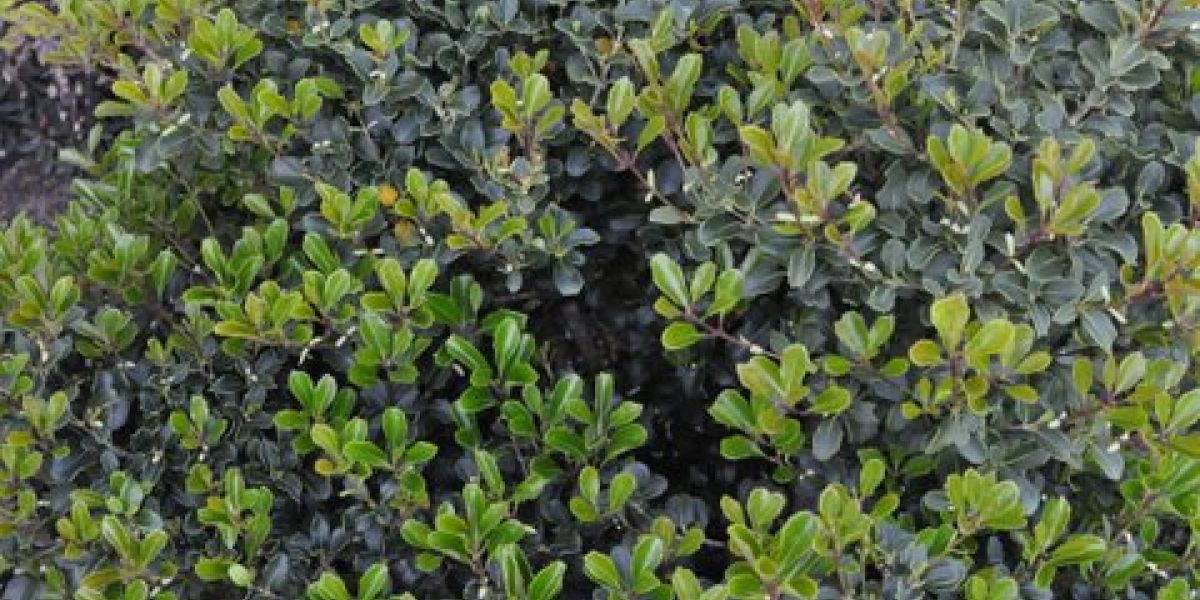Round-leafed Tea Olive
This is one evergreen shrub that looks great all year round. No leaf spot, no diseases or weird pests, no raggedy old brown leaves – just glossy, thick leaves that start out light green and darken to a beautiful holly-like blue green.
As a group, Osmanthus are very easy to grow and seem to be happy in any location. We have them planted on the east, west, and north sides of buildings and all seem to be thriving. A hot spot against a south-facing wall wouldn’t necessarily be our first choice, but they do seem to acclimate to where they are placed and will even tolerate clay soil, as long as it doesn’t stay boggy. Give them regular summer water to get established and they can be quite drought tolerant.
Osmanthus will be more drought tolerant in a shadier location, but our established ones are rudely ignored and haven’t complained. A thick mulch layer will help any evergreen shrub – or any plant for that matter – retain moisture and withstand the changes in temperature. This variety of Osmanthus is hardy to Zone 6 and has shown no winter damage through Rogue Valley winters. Like most Osmanthus it produces small, white, sweetly fragrant flowers; typically in late fall/winter.
Osmanthus heterophyllus ‘Rotundifolius’ is the smooth leafed option of hollyleaf Osmanthus. It will eventually get about 8’x8′, but can be pruned easily to a 4-5′ shrub. It is not fast growing but puts on steady growth each year and won’t overrun its location. Flowers are borne on last year’s growth, so for best flowering prune it back in late winter once it is done blooming. This is a great foundation plant or background for showier perennials. Unlike many other varieties of Osmanthus, ‘Rotundifolius’ has rounded leaves with only slight spines – nothing to cause damage to the pruning gardener.
O. ‘Rotundifolius’ can be deer resistant once established since it has thick, leathery leaves. But in heavy deer country it can have a hard time getting settled if the deer constantly eat the new growth. Other varieties of Osmanthus (see below) have much pricklier leaves and tend to be more deer resistant. To be on the safe side, plan on caging your Osmanthus for the first few years if you have a heavy deer population.
As you can probably tell right now, we really like Osmanthus here at Shooting Star Nursery. Here are a few other varieties that we carry regularly:
Osmanthus delavayi: Deep blue-green leaves with graceful, arching branches. Tends to bloom later than other Osmanthus varieties (April). Fast growing, 6-8’ tall and wide.
 Osmanthus ‘Goshiki’ (photo left): Gorgeous cultivar! New leaves are cream-colored tinged with rose pink, maturing to dark green with creamy-yellow splashes. Slow growing and poky-edged, about 4’ by 4’. Fun fact: ‘Goshiki’ means five-colored in Japanese, a reference to the variegated leaf coloring.
Osmanthus ‘Goshiki’ (photo left): Gorgeous cultivar! New leaves are cream-colored tinged with rose pink, maturing to dark green with creamy-yellow splashes. Slow growing and poky-edged, about 4’ by 4’. Fun fact: ‘Goshiki’ means five-colored in Japanese, a reference to the variegated leaf coloring.
Osmanthus heterophyllus ‘Gulftide’: A fast-growing, columnar Osmanthus – a nice alternative for a hedge or privacy screen with more prickly leaves. About 10-15’ tall by 5-10’ wide at maturity but can be pruned smaller
 Osmanthus ‘Purpureus’ (photo right): As the name suggests, this Osmanthus features lovely purple-black new leaves that change to deep green as they mature. About 6-10’ tall and wide; color best in full sun.
Osmanthus ‘Purpureus’ (photo right): As the name suggests, this Osmanthus features lovely purple-black new leaves that change to deep green as they mature. About 6-10’ tall and wide; color best in full sun.
Osmanthus x fortunei ‘San Jose’- another upright form that gets 15-25′ tall and 7-10′ wide but can be pruned smaller
Osmanthus heterophyllus ‘Sasaba’– an exceptionally sharp leafed variety that will be good about keeping out deer, can get 9′ x 6′ but can be kept pruned smaller
 Osmanthus heterophyllus ‘Variegatus’ (photo left): Dark green holly-shaped leaves that are edged n white – a really striking plant! Moderate grower, about 8’ by 8’.
Osmanthus heterophyllus ‘Variegatus’ (photo left): Dark green holly-shaped leaves that are edged n white – a really striking plant! Moderate grower, about 8’ by 8’.

